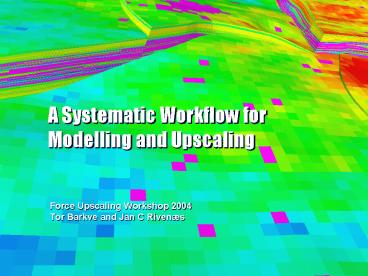A Systematic Workflow for Modelling and Upscaling - PowerPoint PPT Presentation
1 / 27
Title: A Systematic Workflow for Modelling and Upscaling
1
A Systematic Workflow forModelling and Upscaling
- Force Upscaling Workshop 2004
- Tor Barkve and Jan C Rivenæs
2
A modellers eye test
W E R E A L Y H A T E
LZXUPSCALINGQWS BUTWEHAVETOLIVEWITHIT AHFGRLSXVCP
TYUSZØLASSNDFGWAQTSRAYSU
3
Modelling and data rescaling
ECONOMIC AND STRATEGIC DECISIONS
FLOW MODELLING
DATA RESCALING
RESERVOIR DESCRIPTION
DATA RESCALING
CORE AND LOG DATA
DYNAMIC WELL DATA
OUTCROP DATA
SEISMIC DATA
4
Building a sand-castle?
Where should I focus in the modelling
process? How should I treat uncertainty?
5
The art of planning
GEOPHYSICS
PETROPHYSICS
RESERVOIR
GEOLOGY
6
Establishment of standards
7
The art of planning
The main purpose is to establish a common
understanding of modelling purpose, modelling
challenges and modelling resources.
The geologist is a working on a scale we cannot
use
DISCUSSING THE MODEL PLAN?
The reservoir engineer is destroying the geo
model by upscaling
8
What is upscaling?
Upscaling is finding a coarse-scale value
representing the effect of a fine scale
distribution.
A cynic would describe upscaling as a process of
putting incorrect information into the wrong
model to get the right answer. Mike King, BP
The answer my friend, is blowing in the wind. Bob
Dylan, Not BP.
9
The upscaling stages
10
Scale selection
DATA AND OBSERVATIONS
WORK LOAD
PHYSICAL MODEL
MODEL PURPOSE
11
Definition of scales
Adapted from Pickup and Hern (2002)
100
Para- sequences
10
Flow model
Geological model
Log
1
Vertical thickness (m)
Core
0.1
Beds
0.01
Probe
Laminae
0.001
0.001 0.01 0.1 1.0
1 10 100
1000 10000
Horizontal length (m)
12
Selecting scales Geological view
The coupling between small-scale properties and
fluid flow not well understood.
13
Selecting scales Geophysical view
Impedance log
Overbank
Seismic data resolution is often not good
enough to identify flow elements
Channel
3D seismic impedance
Oseberg Ness
14
Selecting scales Dynamical view
Which scales can be detected from dynamic data
only?
Cost-Efficient Reservoir Characterization Project
at Rogalandsforskning Supported by Eni, Hydro
and Statoil
15
Selecting scales Mathematical view
ALIASING Modelling errors caused by discrete
data representation.
NYQUIST SAMPLING THEOREM To avoid aliasing, the
grid cell size should be at least half the
characteristic length of the object sampled.
16
Selecting scales Purpose
NON-FACIES MODEL Three length scales Trend,
correlation length, stochastic variation
HORIZONTAL PERMEABILITY Data uncertainty much
larger than upscaling uncertainty VERTICAL
PERMEABILITY ???
17
The upscaling stages
DEFINITION OF SCALES
18
Data filtering
- Correct preparation of logs is perhaps more
important - than selection of upscaling average
- Removal of shoulder effects
- Use of bias logs
- General recommendations
- Avoid use of cut-off in logs
- Use PHIE and KHE
- Consider cut-off in geo to sim upscaling
19
The upscaling stages
DEFINITION OF SCALES
20
Sampling methods Logs
Blocking of wells
21
Sampling methods Grids
- Sampling is an major error source.
- Grid correspondence should be attempted.
- Geo grid and sim grid should be constructed
together.
22
Half-cell upscaling
Transmissibility upscaling
- Upscale to dual grid
- Use Eclipse keyword LINKPERM
23
Sampling and geology
24
The upscaling stages
DEFINITION OF SCALES
25
Selection of averages
Create upper bound Create lower bound Create
improved upper bound
Reference Beckner Kumar SPE Res.Eng. August
2001
26
Averages and geology
Averages are typically symmetrical Upwards
coarsening sequence or upwards refining sequence
is irrelevant.
More work needed!
27
Summary and conclusions
Upscaling methods must be evaluated based on
their role in the total work process. Upscaling
methods are rather coarse but cannot be
evaluated independent from other
uncertainty. Four aspects of upscaling are
generally equally important Selection of
scales Data filtering Sampling Averaging Ma
in challenges for upscaling are Vertical
permeability Facies boundaries

